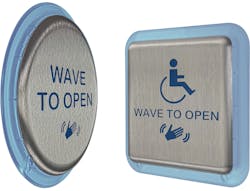Wave To Open: Touchless Door Activation For Hospitals
by Reid Harper, BEA, Inc.
Ebola. MRSA. Sars. Pneumonia. Influenza. The common cold. Some infections make national headlines, some make you miss work and others just make you miserable. No matter what the ailment, they should all make you think twice about the importance of hand-hygiene.
For those who spend enough time inside a healthcare facility, it’s nearly impossible to avoid contact with a contaminated surface at one point or another. Couple this with studies that show nearly 80 percent of infectious diseases are transmitted by touch and you make a strong case to reduce the number of “touch points” in a medical facility.
The Catch 22: Those who come down with a serious infectious disease will eventually seek medical attention. The never-ending cycle of sick people coming in and out can make hospitals an epicenter of outbreaks. The influx of sick people moving through a medical facility almost guarantees the dispersion of germs. As the doctors, staff, patients, visitors and equipment move throughout the building, so do the germs.
A study by the University of Massachusetts-Amherst demonstrated the vulnerability of door handles by showing the accumulation of bacteria on a door handle only 15 minutes after they were disinfected. The colonies of bacteria rose sharply in the hour following disinfection. The door handle, located at the entrance to a dining hall, was a commonly used access point by students coming in and out of the dining hall.
A hospital study cited by the CDC reports that of the 2,834 observed opportunities for hand hygiene, on average, healthcare workers complied with hand hygiene requirements only 48 percent of the time. A separate study of intensive care units cited by the World Health Organization found that adherence to hand hygiene practices was 70 percent during less busy periods and 25 percent during busier periods.
Reducing Cross Contamination
Reducing hospital infection rates has been a priority for healthcare facilities worldwide. Touchless activation is a key weapon in the fight against controlling cross contamination.
Access points and door handles are some of the most vulnerable areas in healthcare facilities for the spread of HAIs. Unfortunately, they are also some of the busiest and most commonly touched areas. Entrances and exits, bathrooms, patient rooms, waiting rooms, surgical rooms, cafeterias—all of these have doors. Consider that every patient room in a hospital has at least two doors (entrance and bathroom) Sadly, it only takes one careless person to contaminate a door handle that could end up cross contaminating a much larger group.
Touchless Activation Devices for doors, activation switches, restroom applications, water fountains and other areas play a key role in reducing the spread of diseases in vulnerable areas.
Stopping the Spread: Touchless Activation 101
- Maintaining Sanitary Workflow – In surgical rooms, HAIs can be an extremely serious issue. When a medical team is scrubbed and fully prepped for surgery, it is imperative that the room and people in it remain sanitary. Wave to Open activation devices provide a simple, and effective means of egress into these rooms, eliminating the need for physical touch and removing a possible point-of-contamination.
- Create Trained Traffic – Touchless activation provides added benefit to those who frequently use a corridor doorway. The traffic becomes accustomed to the activation process and “waving a door open” becomes second nature. In essence, the act of signaling the door to open becomes part of their routine.
- Durable and Professionally Rated – While touchless activation plates do not need to be touched, they still must be capable of withstanding the daily rigors of a busy hospital. Carts, beds and other wheeled objects can easily break plastic switches. Cleaning agents can further corrode the internal and external components of a plastic switch. When choosing touchless activation, strongly consider a plate that is stainless steel and with a NEMA 4 rated enclosure
- Visible and Audible – In today’s hospital, ADA compliant push plates are necessary solutions for door automation. For maximum effectiveness, touchless plates should be accompanied with both visible and audible alerts to further aid in the successful signaling of a door’s activation. In dimly lit areas, illuminated activation plates improve both visibility and accessibility. Adjustable audible alerts can be turned on to confirm activation or turned off to comply with guidelines requiring hospitals to reduce ambient noise.
- Adjustable Touchless Detection Zone – Touchless “zones” can be adjusted to create desirable ranges a person must be within to achieve activation. Having choice in touchless plates, or being able to tune touchless plates to the right sensitivity is critical. For instance, in a surgical room, it is important that the door is not inadvertently or constantly opened in error. In this environment, a “short range” touchless solution should be employed. In a corridor, where patients are constantly being moved, a longer detection zone would represent convenience.
Conclusion
Touchless activation devices are effective and intelligent ways to safeguard your facility, your employees and your customers. By installing touchless door activation devices on your doors, you’re eliminating the need to touch extremely vulnerable and commonly touched items such as handles, push bars and other access methods.
As germs grow more aggressive and resistant to antibiotics and other treatments, it’s imperative to safeguard healthcare facilities as much as possible. Touchless activation plates are an extremely effective way to do this.
For more information, contact BEA, e-mail [email protected]. Phone: 800.523.2462. Websites: www.wavetoopen.com and www.beainc.com.
Reid Harper isTouchless Activation Specialist with BEA, Inc.
